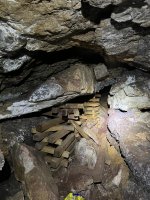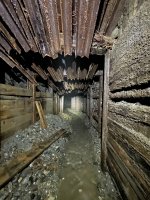legendrider
Active member
My 10-penn'orth.
Use 6-8ft lengths of twinwall pipe cut in half lengthways
Build packwalls either side of the level as high as possible, then lay section of pipe on top as the arch former (in an inverted 'U' profile)
Pack the void above with shale blocks and rubble as the dig moves forward.
Dont forget to chock the bottom of the arch tightly against the living rock to prevent lateral displacement.
The crafty bit here is that with careful dimensional control, more half-pipes can be brought through as required, impossible if the pipe is kept whole!
I think there may be some spare twinwall pipes by the Stamps house at Nent
hope this is useful
MARK
Use 6-8ft lengths of twinwall pipe cut in half lengthways
Build packwalls either side of the level as high as possible, then lay section of pipe on top as the arch former (in an inverted 'U' profile)
Pack the void above with shale blocks and rubble as the dig moves forward.
Dont forget to chock the bottom of the arch tightly against the living rock to prevent lateral displacement.
The crafty bit here is that with careful dimensional control, more half-pipes can be brought through as required, impossible if the pipe is kept whole!
I think there may be some spare twinwall pipes by the Stamps house at Nent
hope this is useful
MARK



